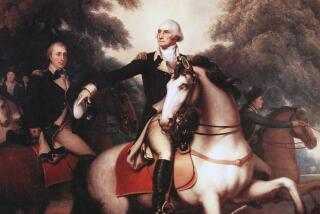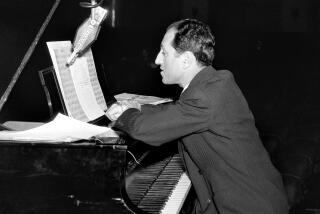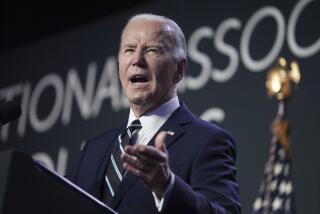Related story: ‘Star-Spangled Banner’: Anthem was once a song of drinking and sex

Americans this weekend will celebrate the 200th anniversary of the poem that became the nation’s national anthem, a bit of verse written by a pro-slavery lawyer put to the melody of a British song that praised drinking and sex.
Oh, say what?
Yes, the song that has been the nation’s musical glue through war and peace, the song that has been the bane of singers of all ages and creeds and led to performances both tragic and mesmerizing, and the song lip-synced by zealous fans at sports events near and wide, yes, that song is celebrating a milestone birthday.
For the area around Baltimore, the birthplace of the anthem, the celebration is a major tourist draw, prompting spectacles such as tall ships, aerial acrobatics star-studded concerts and fireworks. On Friday, President Obama traveled to Ft. McHenry to view the original manuscript.
But national anthems are strange creatures, reaching deep into the past and then taking a twist through contemporary politics and culture.
For Germans, for example, their anthem’s music was written in 1797 by Joseph Haydn to celebrate the birthday of the Emperor Francis II of the Holy Roman Empire. It is the same music that served the Nazi era and is used today for the reunified Germany -- though the words are different.
As anthems go, the United States’ effort is also complicated.
This weekend is the anniversary of the bombarding of Fort McHenry during the War of 1812’s Battle of Baltimore on Sept. 13 to Sept. 14, 1814. At dawn, Francis Scott Key was able to see the U.S. flag waving over the fort, as he noted in his opening lines.
Key was on a British ship, part of a U.S. delegation to negotiate a prisoner release. He was kept on board to prevent the American forces from being tipped off about the forthcoming bombing by the British.
He was allowed to return to Baltimore on Sept. 14 and was so inspired by the U.S. pluckiness that he wrote a poem, “Defence of Fort M’Henry,” which he published on Sept. 20, 1814.
And if you think music sampling -- the art of taking a piece of music from one song and using it in another -- was invented by hip-hop artists, take out your history books.
Key wrote his poem to fit the beat and melody of British composer John Stafford Smith’s “To Anacreon in Heaven” -- a popular tune Key had used for an earlier hymn to America’s military might, “When the Warrior Returns,” which celebrated U.S. heroes of the First Barbary War.
Neither Key’s early hymn nor the Barbary War is widely taught in American schools anymore (except for the reference in the Marines’ Hymn: “To the shores of Tripoli”).
In another example of American music sampling (which some simply call plagiarism), the melody for “My Country, ‘Tis of Thee” is repurposed from the British national anthem, “God Save the Queen.”
Most elementary school classes note that the music for “The Star-Spangled Banner” came from a British drinking song. But in his well-received book, historian Marc Ferris, author of “Star-Spangled Banner: The Unlikely Story of America’s National Anthem” (Johns Hopkins University Press, August 2014) gives a more sophisticated reading.
“The words of ‘To Anacreon in Heaven,’ the song that Francis Scott Key borrowed for the melody of ‘The Star-Spangled Banner,’ is a sly 1700’s paean to drinking and sex. Though understated, the line ‘I’ll instruct you, like me to entwine; The myrtle of Venus with Bacchus’s vine’ is unambiguous,” he wrote.
For the record, Venus is the goddess of love and Bacchus, the god of wine, and “entwine” is defined in any dictionary.
Key’s poetic effort grew in popularity over the years, but sectarian interests hindered the drive for a national anthem. Who thinks about unity during a Civil War? New lyrics were added to reflect that war, but disunity was the watchword and the era became more attuned to the “Battle Hymn of the Republic” and “Dixie.”
Still, “The Star-Spangled Banner” continued to gain in popularity over the decades and was backed by John Philip Sousa, who knew a thing or two about rousing music. It was officially made the national anthem in 1931 by President Hoover.
Then another set of troubles began.
The song, while patriotic, is a magnet for questionable performances: It moves through a variety of octaves, making it hard to sing. Also, because everyone knows the song, many performers try to figure out a way to put their own unique stamp on it.
Whitney Houston is generally credited with giving among the best performances of the anthem at Super Bowl XXV with her flawless vocal range. The worst performance is a question of taste, but many lists would certainly include Roseanne Barr, who grabbed her crotch.
Of course, you can always limit your repertoire to “Happy Birthday.”
Follow @latimesmuskal for national news.
More to Read
Start your day right
Sign up for Essential California for news, features and recommendations from the L.A. Times and beyond in your inbox six days a week.
You may occasionally receive promotional content from the Los Angeles Times.







